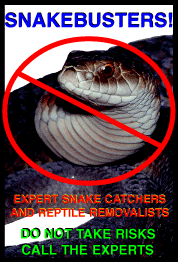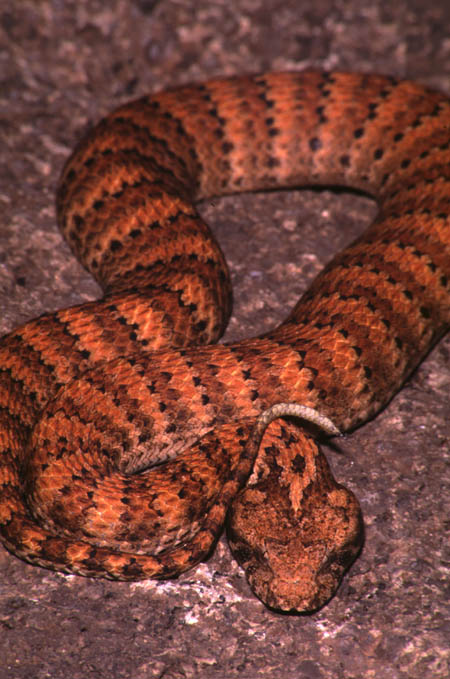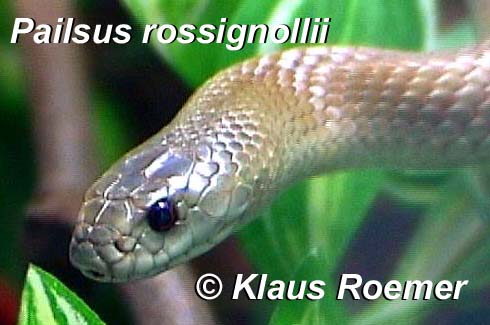|
A NEW SUBSPECIES OF ELAPID (SERPENTES: ELAPIDAE) FROM NEW GUINEA |
Raymond Hoser
488 Park Road, Park Orchards, Victoria, 3134, Australia.
Phone: +61 3 9812 3322 Fax: 9812 3355 E-mail: XXXX
Originally published in Boydii - Journal of the Herpetological Society of Queensland Incorporated - Autumn 2003 (May):pp. 2-4.
The herpetofauna of northern Australia and New Guinea have been the subject of intense study over recent years as more specimens have been exported to the USA and Europe. In recent years a number of new skinks, monitors, pythons and elapids have been described from the Islands north of Australia, including the New Guinea landmass. This paper continues this reclassification process by formally naming the New Guinea subspecies of the Eastern Brown Snake (Pseudonaja textilis).
PREAMBLE
Most authors recognise just one form of the Eastern Brown Snake (Pseudonaja textilis). This is in spite of a number of other names used for variants of this species as set out in Cogger et. al. (1983) and also by Wells and Wellington (1983 and 1985).
Some regional variants of the Eastern Brown Snake were elevated to full species status by Wells and Wellington in 1983. They expanded this process in their paper Wells and Wellington (1985).
This author’s view is that the move was not warranted, but that the variants described are however validly named subspecies.
They are thus classified here as follows:
Pseudonaja textilis textilis (Dumeril, Bibron and Dumeril, 1858) the type species from Eastern NSW and nearby areas.
Pseudonaja textilis inframacula (Waite, 1925) from the Eyre Peninsula, SA - usually darker than the nominate subspecies.
Pseudonaja textilis bicucullata (McCoy, 1879) from Victoria - a slightly smaller variant than the nominate subspecies.
Pseudonaja textilis ohnoi Wells and Wellington, 1985 from Central Australia. Believed to be restricted to the McDonnell Ranges of Central Australia.
It is certain that other variants within Australia await formal recognition.
The status of the specimens from the Kimberley region of WA and the reddish brown animals from the Western Plains of NSW is uncertain.
The species Pseudonaja textilis is variable in colour, although most adults are uniform in colour dorsally.
They may range from light tan, through dark brown, russet and orange to almost black, or any shade in between the preceding. The belly is usually cream or yellowish-orange with scattered darker blotches. Hatchlings vary between localities. However most have a black head. The juvenile pattern usually fades at about two years of age.
In coastal areas of NSW and nearby places, young specimens are usually banded (black bands) all along the body. In some areas, young may be born with or without bands, even from the same clutch of eggs.
The species is known from all Australian States, however in the NT, it is only known from the McDonnell Ranges and adjacent areas, while a single specimen is known from WA (Gordon Downs, in the Kimberley District). In the other (Eastern) states the species is most common in wetter regions, although within these areas, they prefer open woodland and grassland type habitats, where they are sometimes extremely common. The species does not occur in Tasmania.
Scales are smooth with 17 mid-body rows, 185-235 ventrals, a divided anal and 45-76 paired subcaudals. Occasionally the first (anterior) subcaudals may be single.
In most areas adults average about 1.5 metres, but in Coastal Queensland adults over 2 metres are common.
This swift-moving diurnal species will usually flee if aroused, but if cornered will stand it’s ground raise it’s head and become highly aggressive.
It is a highly dangerous species.
The venom is toxic and the species is one of the most common causes of snakebite deaths within Australia.
This reflects the fact that the species is tolerant of human habitation and in many areas has actually increased in numbers, particularly around the edges of the capital cities of Sydney, Melbourne, Adelaide and Brisbane.
The species feeds on vertebrates, including introduced mice (Mus musculus). 10-35 eggs are usually laid.
Other Pseudonaja are separated from this species by a suite of characters including scalation, and the colour of the buccal cavity.
The most closely related to Pseudonaja textilis are Pseudonaja affinis Gunther, 1872 and Pseudonaja tanneri (Worrell, 1961), both of which are separated from Pseudonaja textilis by having 19, instead of 17 mid-body rows, (Wilson and Knowles, 1988).
Other genera of similar looking elapid snakes (e.g. Pailsus, Oxyuranus and Cannia) are separated by colouration, build, scalation and other physical characteristics.
Refer to Cogger (1986 or 1992) and Hoser (1998) for further information about separating these similar genera.
Photos of Pseudonaja textilis in life are provided by Ehmann (1992), Gow (1989), Hoser (1989), and Mirtschin and Davis (1992), Storr, Smith and Johnstone (1986), Worrell (1970) and other authors.
Pseudonaja TEXTILIS Pughi SUBSP. NOv.
HOLOTYPE:
A male specimen in the American Museum of Natural History (AMNH 73959) collected by the Archbold Expedition in 1953 from Baiawa, Moi Biri Bay, Milne Bay Division, Papua 9°35’S, 149°25’E.
It has 17 mid body rows, 205 ventrals, divided anal, over 25 subcaudals.
PARATYPE:
A female snake with a skinned head in the American Museum of Natural History (AMNH 73949) from Menapi, Cape Vogel, Milne Bay Division, Papua 9°40’S, 150°05’E, also collected by the Archbold Expedition in 1953. The snake had 17 mid body rows, 200 ventrals, divided anal and over 45 subcaudals.
DIAGNOSIS:
Pseudonaja textilis pughi is the New Guinea variant of the Eastern Brown Snake.
Physically, adult Pseudonaja textilis pughi are essentially similar to northern Australian Pseudonaja textilis save for the fact that they have 12 solid maxillary teeth as opposed to 9-11 in north Australian specimens (McDowell 1967).
In terms of colouration, anecdotal evidence suggests that New Guinea specimens are darker on average than their Eastern Australian counterparts.
Specimens seen by this author in life have had the following colour traits. The adults have always had a head lighter in colour than the body. This head colour has varied from a orangeish yellow-brown in colour to an almost whiteish-brown (depending on the specimen), while the dorsal body colour has remained a somewhat darker olive to brownish colour, with less red and yellow hue than in the head.
The anterior tips of the scales are lighter than the posterior ones, which may be nearly black. Although there is no etching as such as seen in some other kinds of elapids. However at a distance these snakes appear to be an even olive-brown dorsally. Ventrally these snakes are a yellowish colour, with each scale usually having a thin orange blotch or smudge at the posterior of each scale, these markings not necessarily being even across the entire ventral surface of the scales.
The subspecies is found throughout Island New Guinea, including Irian Jaya, wherever suitable habitat occurs and is common in some areas. All Pseudonaja textilis in New Guinea are Pseudonaja textilis pughi.
Contrary to a number of assertions in recent times as published on the internet and elsewhere, including O’Shea (1996) (who then rebuts the theory), Pseudonaja textilis pughi are not Australian Pseudonaja textilis introduced onto the Island of New Guinea this century by inadvertent means. Such a theory cannot explain the wide distribution of the species on New Guinea, including the fact that populations are widely separated by unsuitable habitat.
The subspecies prefers open Savannah woodland habitat and is common around Merauke, Irian Jaya (Tim Nias, personal communication, February 2001).
Pseudonaja textilis pughi like other Pseudonaja textilis are not commonly kept in captivity due to their relative aggressive nature and toxic venom. The shortage of captives is not because they are rare in the wild or hard to find as this is not the case. However when kept, Pseudonaja textilis have presented few problems. They feed readily on mice (which they usually hold by coiling around when envenoming as seen in Australian P. textilis as shown in Hoser (1989)). This author knows of no breeding records for Pseudonaja textilis pughi but doubts that the species would be difficult to breed.
This subspecies is no doubt commonly confused with other species it is sympatric with, including the New Guinea Pailsus Pailsus rossignollii, Papuan Taipan Oxyuranus scutellatus and Papuan Black Snake Pseudechis papuanas.
Size records and claims for this species should be generally treated with skepticism. Larger specimens tend to increase more in girth than length, thereby easily leading observers to overestimate the length of larger specimens. Any alleged "monsters" should be retained and lodged in a museum on death.
CONSERVATION:
There are no known or foreseen threats. This author sees no reason to restrict the relatively minor trade in live specimens of this subspecies.
ETYMOLOGY:
Named after Mick Pugh. Mick and his wife Mip (whom this species is not named after) have kept and bred numerous species of snakes and lizards for a number of decades in their home town of Geelong, Victoria.
Mip Pugh in particular has bred hundreds of lizards which are now being kept and bred in all Australian states with the possible exceptions of WA and Tasmania where the keeping laws remained restrictive as of early 2001. Mick Pugh became the second president of the Victorian Association of Amateur Herpetologists (VAAH), one of Australia’s leading herpetological societies (founded by Neil Davie). Mick (and a team of loyal helpers) built on Davie’s start to create a hugely successful society with substantial assets and financial backing, furthering the dissemination of information to budding herpetologists throughout Australia and elsewhere.
ETYMOLOGY NOTE:
The name "Pughi" is not to be taken to be in error, or as a mistake for "Pughorum" or similar as would be the correct latinization for when there are two or more persons being honoured by the naming of a species.
This author has, while seeking to honour one or both of the Pugh’s by the naming of species after them, also sought to assign a name that will be easier to use and remember by other herpetologists and therefore chosen the name "Pughi".
ACKNOWLEDGMENTS
Numerous people provided assistance’s in this and related projects. This was mainly in the form of providing literature or providing of study specimens in their care (including museum specimens).
These people included Chris Banks, Brian Barnett, William Bennett, Stuart Bigmore, Joe Bredl (senior and family), Stefan Broghammer, Roland Burrell, Brian Bush, John Cann, Peter and Steve Comber, Tom Crutchfield, Neil Davie, Chris Durham, Euan Edwards, Scott Eipper, Andrew Getties, Dale Gibbons, Russell Grant, Allen Greer, Axel Groenveld, Chris Hay, Matt Hingley, Bob Irwin, Clinton and Debbie Logan, Bill Love, Andrew Lowry, Samuel McDowell, Hayden McPhee, Tim Mensforth, Damien Morphou, Mark O’Shea, Roy Pails, Rob Porter, Mick and Mip Pugh, Ian Renton, Peter Richardson, Frederico Rossignoli, Ross Sadlier, Neil Sonneman, Grant Turner, Paul Woolf, Peter and Judy Wybrow, and Frank Yuwono. A large number of museum curators freely shared their data with this author and/or made specimens available. Most are not acknowledged here by name.
Many others who freely allowed the author to observe live snakes in their care have been omitted from this list.
Literature Cited
Cogger, H. G., et. al. 1983, Zoological Catalogue of Australia: 1 Amphibia and Reptilia, Australian Government Printing Service, Canberra, ACT, Australia. 319 pp.
Cogger, H. G. 1986, Reptiles and Amphibians of Australia, (Fourth Edition), A. H. and A. W. Reed, Sydney, Australia:688 pp.
Cogger, H. G. 1992, Reptiles and Amphibians of Australia, (Fifth Edition), Reed Books Pty. Ltd, Sydney, Australia:752 pp.
Gow, G. F. 1989, Graeme Gow’s Complete Guide to Australian Snakes, Angus and Robertson, Sydney, Australia:171 pp.
Ehmann, H. 1992, Encyclopedia of Australian Animals - Reptiles, Angus and Robertson, Sydney, Australia:495 pp. (Series editor Ronald Strahan).
Hoser, R. T. 1989, Australian Reptiles and Frogs, Pierson and Co. Sydney, Australia:238 pp.
Hoser, R. T. 1998. A New Snake From Queensland, Australia (Serpentes: Elapidae). Monitor - Journal of the Victorian Herpetological Society 10 (1):5-9, 31.
McDowell, S. B. 1967. Aspidomorphus, a genus of New Guinea snakes of the Family Elapidae, with notes on related genera., Journal of Zoology, London, UK, 151:497-543.
Mirtschin, P. and Davis, R. 1992, Snakes of Australia, Dangerous and Harmless, Hill of Content, Melbourne, Australia:216 pp.
O’Shea, M. 1996. A Guide to the Snakes of Papua New Guinea, Independent Publishing Group, Port Moresby, PNG. 251 pp.
Storr, G. M., Smith, L. A. and Johnstone, R. E. 1986. Snakes of Western Australia. Western Australian Museum, Perth, WA.
Wells, R.W. and Wellington, C.R. 1983. A synopsis of the class Reptilia in Australia, Australian Journal of Herpetology, 1 (3-4):73-129.
Wells, R.W. and Wellington, C.R. 1985. A classification of the Amphibia and Reptilia of Australia, Australian Journal of Herpetology, Supplementary Series, (1):1-61.
Wilson, S. K. and Knowles, D. G. 1988, ‘Australia’s Reptiles.’ A photographic Reference to the Terrestrial Reptiles of Australia, Collins Publishers, Sydney, Australia:477 pp.
Worrell, E. 1970, Reptiles of Australia, Angus and Robertson, Sydney.
Hard copy originally published in Boydii - Journal of the Herpetological Society of Queensland Incorporated - Autumn (May) 2003:pp. 2-4.

 To download the pdf (Acrobat) file of the
exact article as it appeared in the journal Boydii - click here - it will take up to 20 minutes to download with dial-up connections.
To download the pdf (Acrobat) file of the
exact article as it appeared in the journal Boydii - click here - it will take up to 20 minutes to download with dial-up connections.
